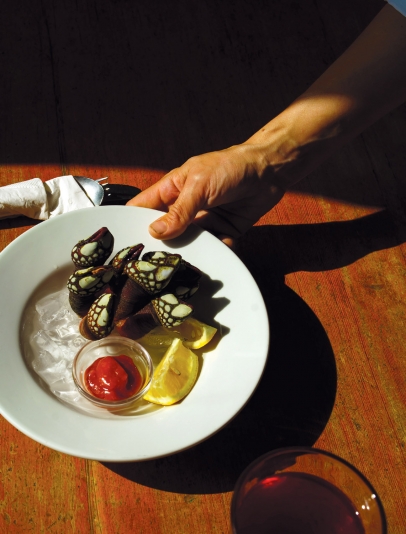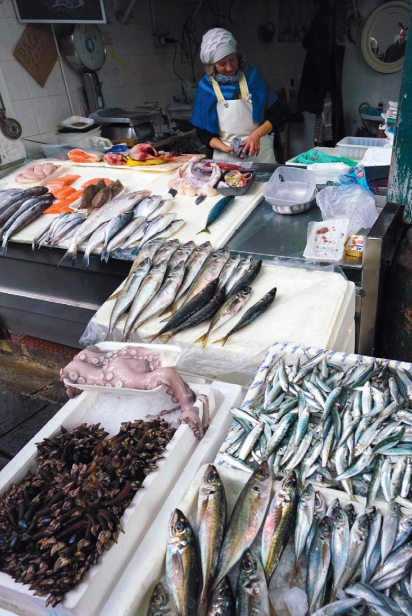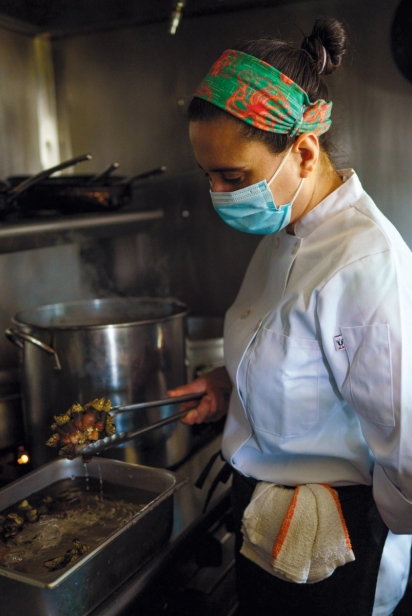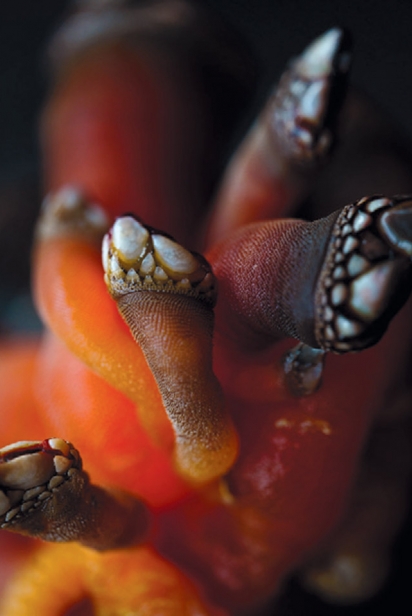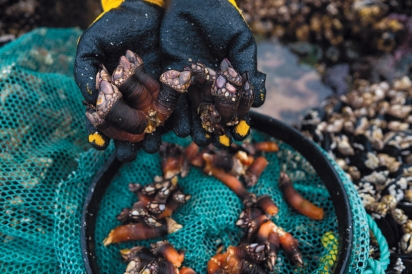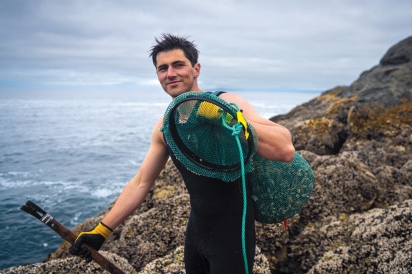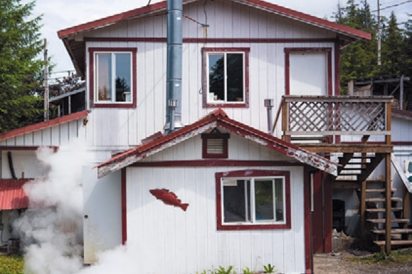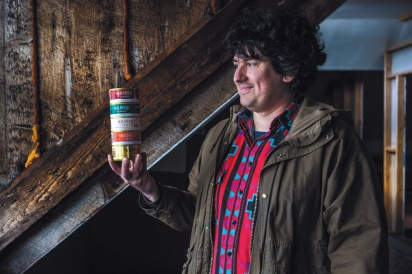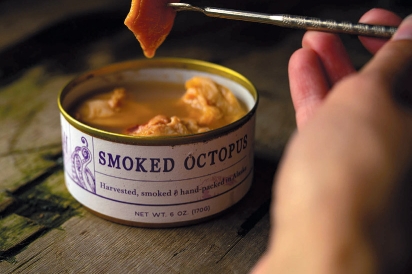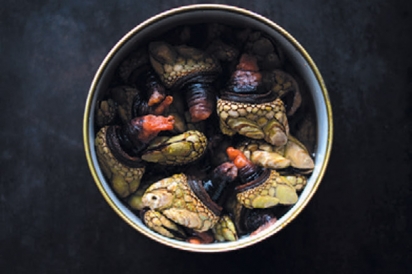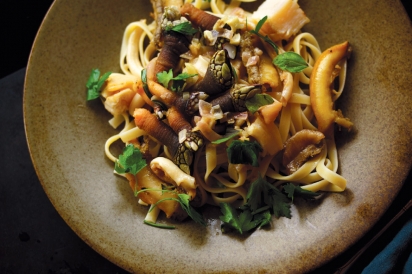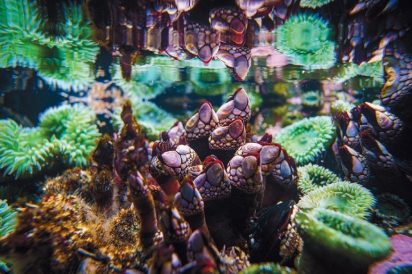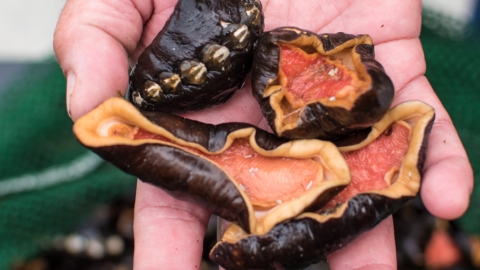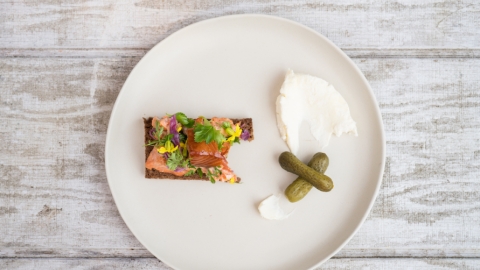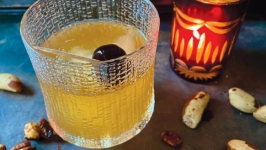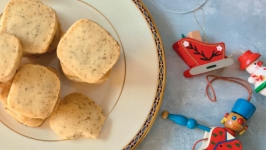Barnacles for Dinner
Bite into the Unusual
Alaska dinner plates are often decorated with time tested foods from the lands and waters that surround us. Some recipes have been passed forward through generations—arguably for thousands of years.
In Southeast Alaska, a diver, cannery, and chef are making space for something new. Meet the gooseneck barnacle.
A Portuguese fishmonger displays the day’s local catch. In seaside regions of Spain and Portugal, gooseneck barnacles, or percebes, are a delicacy. They fetch a high price at market, sometimes breaking $100 a pound. They also cost a heavy toll on percebeiros, the people who risk life and limb to harvest stocky barnacles from precarious, exposed rocks. Regulated and argued over, the world of percebes is not a new one to these regions. Characterized by auctions, quotas, regulatory associations, poachers, rangers, violence, camaraderie, secrecy, honor, and prestige—each percebe is steeped in a long and storied history before hitting eager taste buds.
A wall of gooseneck barnacles clings stubbornly to exposed rocks on a small island on the outskirts of Sitka Sound. Two main varieties of gooseneck barnacles populate the West Coast from Alaska to Baja. Pelagic goosenecks hitchhike on flotsam and jetsam, driftwood, glass bottles, bits of beach trash, and more. Those harvested commercially glue themselves to crags, cracks, and cliffs—concentrating in areas exposed to heavy wave action. Barnacles, like crabs, are crustaceans. They filter feed nutrition from turbulent waters. The species found in the Pacific differs slightly from the species harvested in Spain and Portugal.
Evan O’Brien harvests gooseneck barnacles under a conservative experimental fishery permit from the Alaska Department of Fish and Game. While collecting and selling barnacles, he also harvests information on species distribution, resource health, markets, and more. While O’Brien’s is the first experimental barnacle permit in the state, fisheries exist for gooseneck barnacles down the coast. In Canada, small fisheries are co-managed with First Nations. Oregon and Washington have also explored possibilities for this small fishery.
O’Brien uses a handmade tool to cleanly harvest barnacles from rocks. His quota last year was 1,500 pounds to be harvested from a wide area. His permit required a precautionary approach, allowing him to harvest 1 percent of the barnacles in a given area. Every ten square feet, he collected one square foot of barnacles. He targeted clumps growing on other barnacles that can be harvested in ways that limit damage to their base. This way, his catch survived long journeys via FedEx or Alaska Air Cargo. He shipped to chefs, restaurants, and individuals in the Lower 48 through E-Fish—an online distributor that connects fresh seafood with foodies and others. He also hand delivered down the road to Renee Trafton of Beak Restaurant in Sitka, and shipped to Mathew Scalleta of Wildfish Cannery in Klawock. O’Brien is eager to identify more Alaskan buyers for his peculiar catch.
“I think my niche going forward is pursuing what is weird and different,” he says. “It doesn’t make sense for me to try to compete with processors for seafood like salmon or halibut. If you are curious and creative though, there are opportunities to experiment, and this is just a fun opportunity to expose people to totally new and unusual foods.”
O’Brien also dives for sea cucumbers, and fishes for swimmer scallops with a second experimental permit he holds. His business is called Merrick Shellfish.
Wildfish Cannery is located in the rural community of Klawock on Prince of Wales Island. Chef Mathew Scaletta, owner and operator of the quaint cannery he inherited from his grandma, balances a stack of tinned seafood. The cannery specializes in Alaska seafood products that span the classic staples like smoked sockeye to the new and different—herring, smoked rockfish with sumac, smoked white king bellies, O’Brien’s scallops, geoducks, octopus, and now… gooseneck barnacles.
“With the octopus (pictured) and geoducks especially, we are excited to bring foods to market that might otherwise be wasted or be low value,” Scaletta says. “For example, the geoducks we use are blown and broken. The octopus is actually an incidental catch from a pot cod fishery. I think the seafood industry can sometimes get stuck in their ways and focus solely on business as usual, mass quantity, and catering to traditional palates and demands. But there’s room for entrepreneurship and invention. Alaska is full of unique flavors to explore and celebrate and when done with care, this can also be respectful of the resource and the communities closest to them.”
Wildfish released their canned barnacles late last year. The flavor of the tinned gooseneck barnacles differs wildly from fresh barnacles. They have a briny oceanic flavor and delicate texture. Scaletta and O’Brien created the tinned barnacles as a shelf stable option for sharing this unique delicacy. Limited in quantity and expensive, tinned barnacles certainly won’t replace smoked salmon in an average Alaska pantry, but they may make their way into special occasion meals.
Renee Trafton prepares fresh barnacles as a dinner special at Beak Restaurant in Sitka, Alaska. She cooks barnacles in the same manner she prepares crab (they are crustaceans after all)—lowering them into a rolling boil of salted water containing lemon, peppercorns, and bay leaves. Gooseneck barnacles are an easy special addition for a restaurant with the motto, “Be adventurous, be sustainable, be healthy, be local, be AK.” Sourcing locally is important for Trafton, who enjoys fostering human to human relationships with fishermen and divers like O’Brien. She believes the practice is good for the community and environment by limiting the distance seafood travels, circulating more money locally, and also by fostering a deeper connection to the lands and waters that sustain us.
“Our mission is to extend a taste of the Southeast Alaska lifestyle for our guests,” she says. “For locals, that’s about welcoming people into our place and fostering community around food. For visitors, we have an opportunity to introduce them to Sitka and how we live. This might be the one meal that they eat here. So if you can give them a perfectly cooked piece of king salmon or introduce them to gooseneck barnacles—they’re going to remember that.”
At Beak Restaurant, the kitchen crew takes a break to try out their newest dish. Percebes, dragon toes, goosenecks, barnacles—whatever you call these oceanic treats, try them fresh if you can. How do you eat a dragon toe? Grab it by the toe or capitulum. Remain calm. Remove the outer textured sheath to reveal the tasty slender neck of meat. Add a little squirt of lemon, a dash of cocktail sauce, dip it in butter, or add nothing at all before munching the meat and twisting off the toe. Fresh, the meat tastes like crab or lobster. Caution (especially for people on first dates): the dragon toes might squirt a little.
Homemade seafood pasta made with friends, featuring rock scallops, abalone, and freshly harvested barnacles from our oceanic backyard. Many Southeast Alaskans hunt, fish, and harvest wild foods from the Tongass National Forest and the surrounding waters. While venison and salmon constitute staples, the opportunity to share and indulge in new flavors and foods helps keep life fresh and interesting.
Gooseneck barnacles filter feed within a colorful tidepool on the outer coast. Little is known about the abundance, distribution, and reproduction of Southeast Alaska’s barnacles. This is why O’Brien’s permit is experimental, conservative, and precautionary. Careful management to ensure the sustainability of the resource is critical. O’Brien is optimistic though. “When Fish and Game issued the permit, they thought the populations would be very patchy—but that isn’t true in my experience if you know what to look for.” For now, O’Brien stewards the resource by spreading his impact even beyond the requirements of his permit. He knows, however, that scaling the harvest to include new divers and permits will require coordination, closures, and care. Populations have been depleted in parts of Europe due to a combination of harvesting pressure, poaching, and environmental and habitat threats such as rising ocean temperature and salinity. Like everything good in life, gooseneck barnacles will need to be enjoyed in moderation. An important part of eating any local wild food is recognizing our responsibility to take care of it.
Editors’ note: a version of this piece was originally published in FORUM, the magazine of the Alaska Humanities Forum; through a partnership, Edible Alaska co-publisher Jeremy Pataky guest edited their Summer 2022 edition, released that August.


